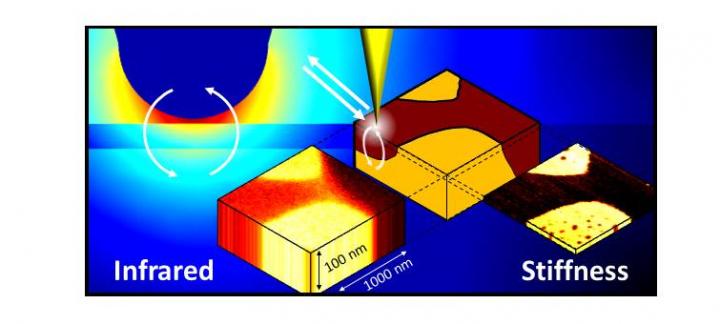
Credit: CIC nanoGUNE
Researchers from the Nanooptics Group at CIC nanoGUNE (San Sebastian) demonstrate that nanoscale infrared imaging – which is established as a surface-sensitive technique – can be employed for chemical nanoidentification of materials that are located up to 100 nm below the surface. The results further show that the infrared signatures of thin surface layers differ from that of subsurface layers of the same material, which can be exploited to distinguish the two cases. The findings, recently published in Nature Communications, push the technique one important step further to quantitative chemometrics at the nanoscale in three dimensions.
Optical spectroscopy with infrared light, such as Fourier transform infrared (FTIR) spectroscopy, allows for chemical identification of organic and inorganic materials. The smallest objects which can be distinguished with conventional FTIR microscopes have sizes on the micrometre-scale. Scientists at CIC nanoGUNE (San Sebastian), however, employed nano-FTIR to resolve objects, which can be as small as a few nanometres.
In nano-FTIR (which is based on near-field optical microscopy), infrared light is scattered at a sharp metallized tip of a scanning-probe microscope. The tip is scanned across the surface of a sample of interest and the spectra of scattered light are recorded using Fourier transform detection principles. Recording of the tip-scattered light yields the sample’s infrared spectral properties and thus the chemical composition of an area located directly below the tip apex. Because the tip is scanned across the sample surface, nano-FTIR is typically considered to be a surface-characterization technique.
Importantly though, the infrared light that is nano-focussed by the tip does not only probe a nanometric area below the tip, but in fact probes a nanometric volume below the tip. Now the researchers at CIC nanoGUNE showed that spectral signatures of materials located below the sample surface can be detected and chemically identified up to a depth of 100 nm. Furthermore, the researchers showed that nano-FTIR signals from thin surface layers differ from that of subsurface layers of the same material, which can be exploited for determination of the materials distribution within the sample. Remarkably, surface layers and subsurface layers can be distinguished directly from experimental data without involving time-consuming modelling. The findings have recently been published in Nature Communications.
###
Media Contact
Irati Kortabitarte
[email protected]
Original Source
https:/
Related Journal Article
http://dx.




